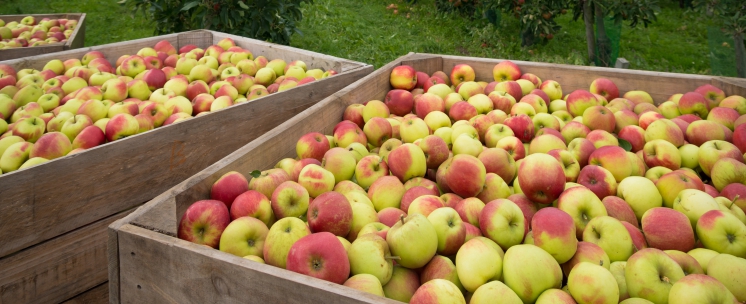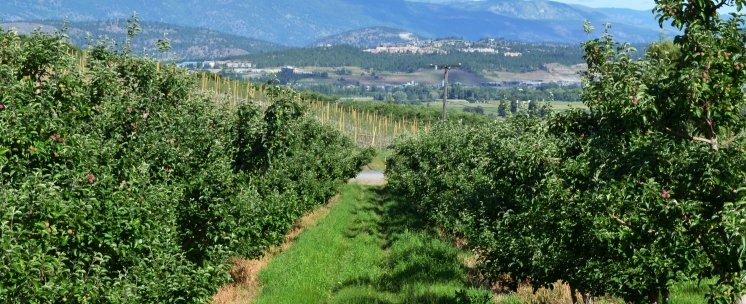Successful control of codling moth under organic production systems requires a thorough understanding of the moth’s life cycle and behaviour, awareness of codling moth levels, and application of management practices to supplement the SIR program area-wide control. The factsheet below describes the recommended management practices conventional and organic growers can apply to reduce and keep codling moth levels below damaging levels.
Organic production is more labour intensive than conventional production. It is important to establish a regular monitoring program to determine when the codling moth is active, and when codling moth populations are highest. Traps baited with pheromone lures are the most commonly used monitoring tool. In the spring, SIR staff sets out pheromone lure-baited traps in every orchard.
It is extremely important to complement moth trap data with visual observation throughout the growing season. The best monitoring method involves walking the orchard at least once each week to look for fruit damage.
Seasonal codling moth control will require a combination of cultural, biological, and organically acceptable chemical approaches. Mating disruption, organically acceptable spray materials, biological controls, cardboard banding, and good orchard sanitation are potential management options for organic orchards.
-
Mating Disruption for Organic Orchards
Mating disruption is a promising codling moth control option available to organic growers, as well as to conventional growers who are looking to diversify their control options. Not all orchards, however, are equally suited to the mating disruption technique. Success with mating disruption depends on the size, shape, and terrain of the orchard, as well as the codling moth pressure. Mating disruption was implemented on an area-wide basis in the central and north Okanagan in a three-year pilot study. However, this strategy proved less effective than the sterile insect technique, and area wide release of sterilized moths was resumed in 2015.
Hang pheromone dispensers at full rate or half rate, depending on the level of infestation and availability of resources (follow the manufacturer’s recommendations). Application of mating disruption should be undertaken in the spring, just before the adult codling moths are expected to emerge (typically in late April). The dispensers should be placed in the upper third of the plant canopy. Dispensers may be concentrated in problem areas (e.g. orchard edges and hot spots) to decrease the likelihood of damage.
More information on mating disruption and SIR can be found in the main Mating Disruption section.
-
Chemical Controls - Organically Acceptable Spray Materials
Codling moth granulosis virus (CMGV)
The target of CMGV is the newly hatched larvae. To be effective, virus particles must be ingested prior to the larvae entering the fruit. CMGV should be applied, therefore, before the larvae enter the fruit. Repeated applications at weekly intervals may be necessary during hatchout. CMGV is most effective when applied at higher volumes (follow the manufacturer’s recommendations).
Summer or Horticultural Oils
Horticultural oils can be effective in low codling moth pressure situations, but are only mildly effective under high codling moth pressure. Oil is primarily effective when applied on top of eggs. Frequent applications are necessary to ensure that eggs deposited after one application do not hatch prior to the next application. It is essential that the volume of water used allows for complete coverage of foliage and fruiting surfaces (follow the manufacturer’s recommendations).
-
Biological Controls
Because the codling moth is not a native pest of the Okanagan Valley, native beneficial insects are not very effective in controlling it. There are a number of generalist predators that eat codling moth, including ground beetles, ants, spiders, earwigs, lacewings and birds. Since they can provide some supplemental control at little cost to the grower, it may be prudent to encourage these predators by providing a suitable habitat in the orchards. Maintain a ground cover that provides shelter for beneficial insects.
-
Cultural Controls
The most important aspect of organic control is eliminating potential sources of infestation from within and around the orchard. Take adequate measures to keep your host trees free of infestation whenever possible during the growing season.
Good sanitation practices include the following.
- timely removal and treatment of all point sources, including wood piles, fruit bins, prunings, stumps, unwanted host tress and other debris that could provide overwintering sites for codling moth
- timely removal and destruction of codling moth-infested fruit
- scraping of loose bark from trees to reduce the number of pupation sites
-
Cardboard Banding for Organic Orchards
Where possible, install cardboard bands twice in the season to catch and destroy first and second brood larvae and pupae. Install banding for first generation larvae in spring, then remove and destroy the trapped larvae and pupae by mid-July to early August before they can emerge as adults. Banding for second-generation larvae should then be applied. Remove and destroy these bands in the fall, or over winter.
More information on cardboard banding can be found in the main Cardboard Banding section.
An organic grower needs the full co-operation of all surrounding growers in order to achieve the best success. It can be extremely difficult to “clean up” an organic orchard that has a poor codling moth management history or is subject to high pressure from surrounding orchards.


